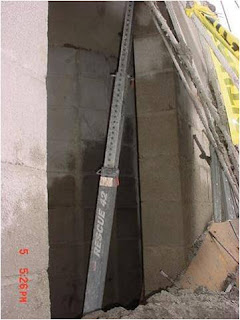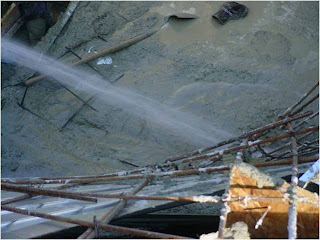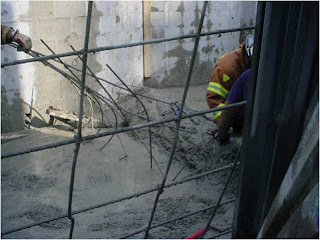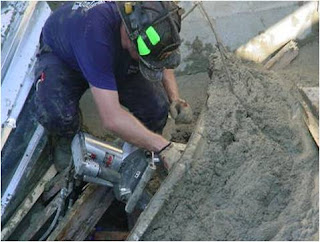The Bathtub Collapse, Part 2
Part 1 of this series from All Hazards Contemplations was an introduction to Bathtub Collapse problem identification, exterior size-up, strategy considerations and development, and safety considerations. Part 2 discusses tactical considerations, interior size-up, victim recovery, investigations, and incident termination. This article was co-authored by my friend and colleague, Jason Walters.
Tactics
In order to make a bathtub collapse rescue safe and efficient, the operation must follow a logical sequence. The first step in this sequence is to support the sides of the bathtub. If the bathtub is formed by structural walls or columns, start by shoring them. Raker shoring systems are a good way to support exterior walls.(1) For masonry or wooden walls, traditional raker shore types are appropriate. Modified split sole rakers may be used to provide columns with lateral support. Visibly stressed walls or columns should be shored first. If the wall or column is leaning or cracked, it’s stressed.
Extrication Strut as a temporary door shore
The next step is to support natural entry points, then open them. Door and window openings can be shored as in any other structural collapse. You may need to frame the edges of the opening with a raker system prior to shoring the actual opening. Once the door opening is supported, additional bathtub components such as metal Q-decking, rebar grids, and other metal components may be cut away to clear the opening for access and egress. Cutting operations create sparks, open flames, or both. Ensure that the building’s gas supplies are shut off and that the area is well-ventilated prior to using cutting tools that create ignition sources. Also ensure that both water and dry chemical extinguishers or a charged hoseline are nearby curing cutting operations.
Cutting Q-decking and rebar obstructions with a rotary saw
Once the interior of the bathtub is accessed, it may be necessary to use strongbacks and tiebacks to support inward-leaning walls. Picket systems or large, well-secured anchors should be used to anchor the exterior tiebacks. Place towels, blankets, etc. over the tieback cables to reduce whipping in the event of cable failure. Once the tieback system is complete, keep everyone out of the immediate area.
Widowmakers
Once the bathtub walls are secure, it’s time to take care of overhead hazards. Identify all widowmakers and eliminate falling object hazards by using one of the following methods;
1. Secure the widowmaker by tying it to solid structural components with cables, chains, come-alongs, etc.
2. Remove the widowmaker by bolting it, then tensioning it with a crane, and cutting it loose from the structure.
3. Avoid the widowmaker by marking and enforcing a collapse zone beneath the widowmaker. This may not be possible, as the victims may be trapped directly below the widowmaker.
Search Tactics
Once the surrounding structure is secured, the interior search can begin. Start by searching voids and by manually removing selected debris.(2) Voids may be searched visually with flashlights, thermal imaging cameras (TICs), USAR or fiber optic search cameras, and by probing voids with pike poles. It is important to note that wet concrete produces heat, and this heat may mask the heat signature of a human body when searching with TICs. Remember that TICs cannot “see” through solid materials such as structural components.
Simultaneously with the void search and light debris removal, other crews may start searching through the wet concrete in the bathtub. You may manually search for gaps in the horizontal Q-deck by simply using gloved hands to probe through the wet concrete and any gaps in the edges of the Q-decking.
Victim Search in a Bathtub Collapse
It is also important to create horizontal openings in the vertical Q-decking parts of the bathtub. This allows horizontal removal of some of the concrete while it is still wet. Hoselines can be used to keep the concrete wet and dilute as long as the water will not run into voids and drown the victim or cause hypothermia. Scoop shovels and even stiff-bristled push brooms can be used to move wet concrete through the bathtub openings. 
Hose Stream dilutes and moves wet concrete
Bathtub Collapses into Basements
If it is necessary to lift wet concrete out of a basement, simple bucket-and-rope systems may be used, but they are manpower-intensive. Vacuum trucks may be useful, but the concrete may be too heavy for the vacuum to lift it very far. Large amounts of water will probably be required to dilute the concrete enough for a vacuum truck to lift it, and that much water may drown the victim prior to completing the rescue. Water also adds weight to an already-damaged structure, which may cause additional collapse. It may be necessary to move large volumes of wet concrete in order to locate the victim. It also may be possible to use a trash/solids pump to move dilute concrete out of a basement if the aggregate size is small enough to make it through the pump without clogging it. A bathtub collapse into a crawl space is generally similar to a collapse into a basement, but may allow grade-level access to one or more sides of the bathtub.
Victim Extrication
Once the victim is located, determine the body position and attempt to expose the airway. If the victim is alive, follow local blunt trauma and crush/compartment syndrome protocols. If the victim is deceased, ensure that all other potential victims are accounted for. If other victims are not accounted for, it will likely be necessary to continue in Rescue mode. If all victims are accounted for and have been determined to have died, then shifting to Recovery mode is more appropriate.
It is likely that rebar will be submerged or semi-submerged in the concrete. Large sections of the rebar grid may be cut away with minimal effort by locating the rebar and cutting it around the outside edge of the area you desire to expose. Cut rebar grid away with hydraulic cutter or large bolt cutters if it is submerged in the wet concrete. Rebar cutters, reciprocating saws, and/or torches may be used to cut any exposed rebar, particularly if only one hydraulic cutter is present.
Hydraulic cutters being used to cut rebar
Removal of rebar grid section
To extricate the victim, it is useful to locate the Q-decking edge closest to the victim. Once this edge is located, it can be used as a purchase point to move concrete and steel away from the victim. A variety of tools and techniques may be successful. Once the Q-deck edge has been located, start moving wet concrete away from it. A good rule of thumb is to move wet concrete away from the hole at least three times the depth of the remaining concrete. This will help prevent wet concrete from running through the hole in the Q-decking and burying the now-exposed victim.
Once adequate amounts of wet concrete and rebar have been removed, it is time to attack the Q-decking. You can start by using the exposed Q-deck edge as a purchase point and lifting the edge with hydraulic rescue spreaders. As you open the spreaders, the Q-decking will start peeling back. You can extend the cuts with hydraulic spreaders or reciprocating saws. If power tools are not available, even hacksaws can be used to cut the Q-decking. Small rescue air bags may be used to lift the Q-deck, but remember that sharp rebar ends or Q-decking edges may cut or puncture the air bags. If using air bags, pad them with sections of rubber matting such as old tractor-trailer mud flap material or short sections of old large-diameter fire hose. Bottle jacks or small scissor jacks can also be used to lift the Q-decking.
Hydraulic spreader used to roll up exposed Q-decking edge
It is not necessary to remove all of the concrete from the Q-decking prior to cutting it. Additional personnel can be used to continue moving concrete away from the victim with scoop shovels. As with any other heavy lifting operation, cribbing must be installed to support the lift. Use the “Lift an inch, crib an inch” cribbing method. It may be possible to use a come-along to support rebar grid sections that are too large for complete removal.
If it is becomes necessary to remove very large sections of Q-decking or other metal components, several cutting methods may be employed simultaneously. These can include alternating hydraulic spreader lifts with hydraulic cutter relief cuts, lifting with a spreader while extending the cut with reciprocating saws, or by removing concrete and steel in an area away from the victim in order to create an intermediate location in which to move materials away from the victim. If using torches, make sure that you do not burn the victim. If using torches remotely from the victim, use an atmospheric monitor near the victim to ensure that torch byproducts are not compromising the victim’s clean air supply.
If it is possible to quickly move a large amount of wet concrete out of the bathtub, consider making purchase points with a hole saw or core drill, inserting short sections of heavy-duty rebar or pickets, and attaching cables in order to lift a large section of steel away.
Prior to removing most of the wet concrete, air chisels and reciprocating saws will be of very little use, since they are designed to use in open air. Pneumatics may have limited utility, but electric tools will quickly burn out and become useless when submerged in wet concrete, due to the saw’s inability to radiate heat into the air.
If the victim is pinned over a secondary void, install supplemental shoring beneath the victim if possible. It may be necessary to install an improvised lifting harness on the victim if a secondary fall possibility is created by the extrication process. If the secondary void is very deep, it may be necessary to have rescuers shore beneath the extrication operation. This is highly dangerous, and is recommended ONLY as a last resort and with IC and Safety Officer approval.
Patient Care
As with any other extrication, provide medical care during the extrication if the victim is alive. If the extrication is prolonged, it will be necessary to provide protection from ambient temperature, extremes of weather, and to provide specialized crush syndrome care. USAR Medical Specialists and paramedics and physicians specializing in cave or mine rescue may be very useful in this situation. USAR medicine may require medications and medical protocols outside of normal EMS procedures. USAR medicine protocols should be approved by local and/or state EMS authorities in advance. It may be necessary to conduct a field amputation in order to save the victim’s life. If possible, a field-qualified physician should make the amputation, as amputations require training and equipment outside the normal paramedic scope of practice.
Once the victim is completely disentangled, package the victim, take any required steps to move the victim outside the structure, and turn the victim over to the transporting unit. All rescuers working near the victim should wear any necessary body substance isolation (BSI) personal protective clothing. If advanced life support (ALS) procedures are in use, EMS personnel should have a sharps container at the patient’s side for IV needles other contaminated sharps disposal.
Third-Party Investigations
If one or more victims are deceased, a scene investigation will be necessary prior to moving the body. The coroner, medical examiner, and/or law enforcement agencies will want to photograph and diagram the scene, interview witnesses, and determine whether any foul play is suspected. If the coroner or medical examiner staff is not trained to enter collapse zones, they may ask that rescuers take scene photos and/or measurements for them. If possible, put the coroner in a location where he/she can direct the rescuers as they take photos and measurements, but do not compromise responder safety to investigate a death.
OSHA investigators may also be on the scene. It is important to note that OSHA investigators do not generally have the authority to interfere with body recoveries, and they do not have the authority to interfere with the rescue of live patients. Fire-rescue and EMS personnel should document any actions they take on behalf of an investigating authority.
It is also important to inform coroner, medical examiner, law enforcement, and OSHA investigators that time is of the essence due to concrete curing. If the concrete hardens with the victim’s body still entrapped, a one or two-hour recovery may become a multi-hour or multi-day recovery operation. Once the body is removed, place it in a body bag, secure it in a Stokes basket, SKED, or other rescue litter, and remove the body from the collapse zone.
Decontamination and Clean-Up
USAR decontamination considerations generally involve cleaning equipment and PPE that may have been exposed to biohazardous wastes and cleaning concrete dust, powdered glass, or other building components from personnel and equipment. Bathtub collapses require an immediate additional step.
Several charged hoselines should be present to remove concrete from responders and equipment while it is still wet. This is particularly true for exposed skin and any tool that was submerged in the wet concrete. Exposed skin is vulnerable to thermal burns from the warm concrete, chemical burns from concrete components, and traumatic injury from rough aggregate or sharp metal edges encountered during the rescue. Concrete will find every nook and cranny in hydraulic rescue tools, bottle jacks, pneumatic hose couplings, pneumatic strut feet, or any other equipment that may have been placed in the concrete. Two or three engine companies assigned exclusively to decon will enable responders and gear to be cleaned quickly, efficiently, and thoroughly.
Termination
As with any other incident, all tools, equipment, and apparatus will need to be returned to service, cleaned, and inspected. Any equipment damaged, destroyed, or contaminated beyond salvage will need to be reported and replaced. Powered equipment will need to be serviced and fueled. It may be necessary to replace large quantities of cribbing and shoring materials, contaminated life safety rope, or other materials that it is unsafe to recover. Do not risk personnel to recover a few pieces of wood that can be easily and cheaply replaced.
Any personnel injury or exposure will need to be treated, reported, and receive any necessary follow-up care. An accurate incident report should be completed, anticipating third-party investigations and possibly criminal or civil actions due to the collapse. An after-action review should be held as soon as all the incident facts can be determined. The critique should involve all personnel and units that participated in the response.
Conclusion
Bathtub collapses have not been previously identified and traditional USAR training does not specifically address collapses involving wet concrete. Wet concrete is not easy to shore or support. Wet concrete adds a new degree of difficulty to USAR searches, as you can’t just drill a hole and look through it with a search camera or fiber optic scope. Wet concrete flows to the lowest point and collects, which can concentrate structural weight in a small portion of the supporting structure. Bathtub collapses add an entirely new set of challenges, even for well-trained and experienced USAR teams. One of the most critical elements is time – the concrete won’t stop hardening while we call resources, shore the structure, or search for the victims.
Concrete buildings may be constructed virtually anywhere. All concrete structures are vulnerable to collapse while under construction. With the increasing demand for structures to house people, businesses, and to repair our country’s aging infrastructure, it is anticipated that bathtub collapses will become more common. Any fire-rescue and EMS agency may be faced with a bathtub collapse. Preparation, safety, equipment, training, and above all, anticipation are important to keep responders safe and to successfully conclude the response to complex and dangerous bathtub collapses.
References
(1) U.S. Army Corps of Engineers
US&R Structures Specialist Field Operations Guide, 3rd Ed.
U.S. Army Corps of Engineers Readiness Support Center, 2001, pp IV-42 – IV-48
(2) Goodson, Carl, et al
IFSTA Essentials of Firefighting, 5th Ed.
IFSTA, Stillwater, OK, p 364
All photos courtesy of Hilton Head Island Fire & Rescue
About the Authors
Ben Waller is a Battalion Chief with Hilton Head Island Fire & Rescue, currently assigned as the Training Chief. Ben is a paramedic, a hazardous materials technician, and a USAR rescue specialist. He is Safety Officer for South Carolina USAR Regional Response Team 4 and is an adjunct faculty instructor in the fire, rescue, and incident command programs at the South Carolina Fire Academy. He is a member of the South Carolina Fire Academy’s Rope Rescue and Water Rescue Technical Development Committees. Ben’s education includes a Master’s of Public Administration degree and undergraduate Fire Administration and Paramedic/Allied Health degrees.
Jason Walters is a Lieutenant with Hilton Head Island Fire & Rescue, currently assigned to an engine/medic company. He is a Rescue Manager with South Carolina USAR SCTF-1 and is the Team Coordinator for South Carolina USAR Regional Response Team 4. He is an EMT-B, a hazardous materials technician, and a USAR rescue specialist. Jason is an adjunct faculty instructor in the fire and rescue programs at the South Carolina Fire Academy. His education includes an Associate of Fire Science Degree from Luzerne County College. Jason has 18 years of experience in fire-rescue, EMS, and hazardous materials response. He has 34 years of experience in fire-rescue, EMS, and hazardous materials response.
Add a Comment
-
Comment by Ben Waller on March 9, 2010 at 8:51pm
-
Oldman, it's always good to have validation from someone who works construction when we're discussing USAR issues. I keep hearing how we've lost all of the firefighters that worked trades and only have people that grew up playing X-Box and PS2. (One of my fellow B.C.s at work is a very, very good electirican, and he's our "go-to" guy on electrical issues. Apparently, we still have some knowledgeable tradespeople around. They are worth their weight in gold.
-
Comment by Oldman on March 9, 2010 at 3:37pm
-
I was talking to my Lt about part 1. His regular job is as a construction superintendent for a company that builds exclusively concrete structures. He obviously had never heard the term bathtub collapse, but he immediately knew what you are referring to. Never having had a floor collapse, he has had forms on columns fail and dump 3-4,000 cu yd of mud onto the floor below. Fortunately so far, nobody has been trapped.
Excellent post.
-
Comment by Ben Waller on March 9, 2010 at 1:17pm
-
CBz,
Part 1 is here:
The term "Bathtub Collapse" is a term that Jason and I coined after we worked one of these a few years back. It is not in the standard USAR terminology, but enough of these occur that we believe the term should be added to the lexicon.
The important differences are that the concrete is wet and runny instead of in rigid slabs. That greatly changes the approach from the standard structural collapse rescue approach.
The one shown occurred in a structure that was Type III on the 1st level and Type V above that. The collapse shown was a pool deck that was being poured at the 2nd floor level between the stick-built part of the structure and the elevated swimming pool and elevated jacuzzi.
We use the term "Bathtub" because the wet concrete runs to the lowest part of the area contained by the Q-deck, the masonry walls, etc. just as the water runs to the lowest point in a bathtub...so the answer is "associative term".
-
Comment by Mike Schlags (Captain Busy) Retd on March 9, 2010 at 12:56pm
-
Ben, Is there anything you do that is not exceptional? Very impressive research and presentation of material, but only truly impressive if you know what you are talking about. For me, one that lives in the land of wood frame construction suburbia and rural america, concrete structures are not the norm...
Not being a USAR guy, I am not familiar with this as a term, e.g. "Bathtub Collapse". Is this in reference to a physical bathtub in a structure or an associative term like pancaking? I know it's part 2 of your series but it's like coming into the middle of a movie, I'm a little lost. Please steer me in the right direction... Inquiring minds want to know! :D
CBz
Specialty Websites
Find Members Fast
Firefighting Videos
© 2025 Created by Firefighter Nation WebChief.
Powered by
![]()
Badges | Contact Firefighter Nation | Privacy Policy | Terms of Service
You need to be a member of My Firefighter Nation to add comments!
Join My Firefighter Nation